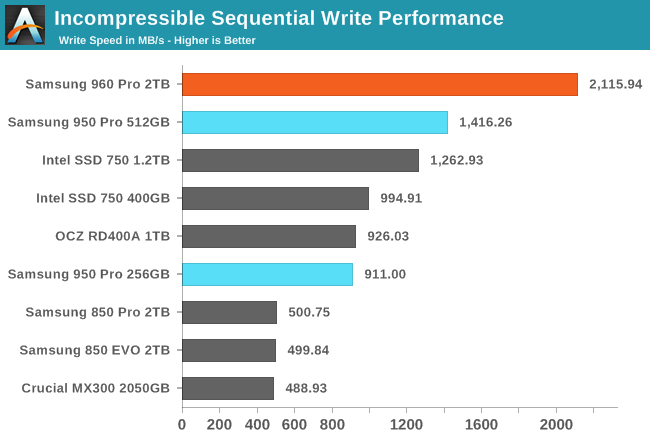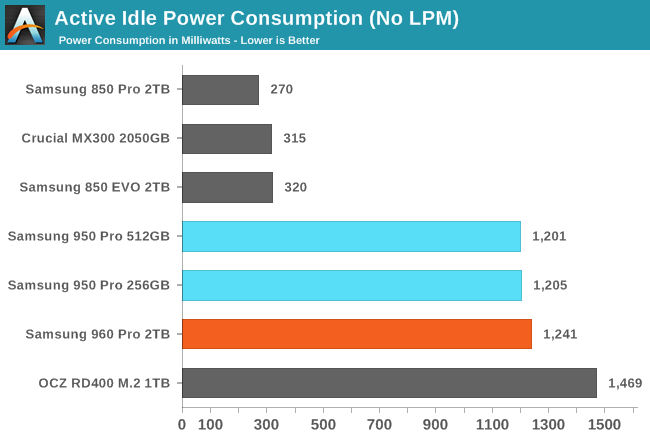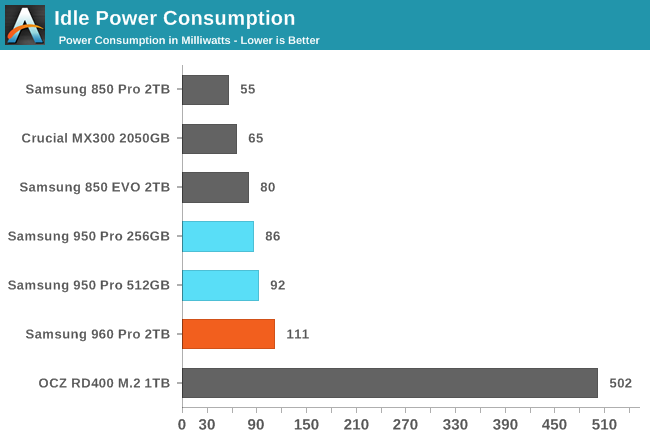The Samsung 960 Pro (2TB) SSD Review
by Billy Tallis on October 18, 2016 10:00 AM ESTATTO
ATTO's Disk Benchmark is a quick and easy freeware tool to measure drive performance across various transfer sizes.
 |
|||||||||
The 960 Pro hits full performance at 32kB or larger transfers, while the Intel SSD 750 doesn't reach its highest read speeds until 1MB transfers and the OCZ RD400 needs 512kB transfers for its highest read speeds. Unlike the 512GB 950 Pro, the 960 Pro does not hit any severe thermal throttling.
AS-SSD
AS-SSD is another quick and free benchmark tool. It uses incompressible data for all of its tests, making it an easy way to keep an eye on which drives are relying on transparent data compression. The short duration of the test makes it a decent indicator of peak drive performance.


The 960 Pro's read speed breaks away from the pack of other PCIe SSDs but still doesn't come close to the advertised 3.5GB/s. The write speed stands out even more and very slightly exceeds the advertised speed of 2100MB/s.
Idle Power Consumption
Since the ATSB tests based on real-world usage cut idle times short to 25ms, their power consumption scores paint an inaccurate picture of the relative suitability of drives for mobile use. During real-world client use, a solid state drive will spend far more time idle than actively processing commands.
There are two main ways that a NVMe SSD can save power when idle. The first is through suspending the PCIe link through the Active State Power Management (ASPM) mechanism, analogous to the SATA Link Power Management mechanism. Both define two power saving modes: an intermediate power saving mode with strict wake-up latency requirements (eg. 10µs for SATA "Partial" state) and a deeper state with looser wake-up requirements (eg. 10ms for SATA "Slumber" state). SATA Link Power Management is supported by almost all SSDs and host systems, though it is commonly off by default for desktops. PCIe ASPM support on the other hand is a minefield and it is common to encounter devices that do not implement it or implement it incorrectly. Forcing PCIe ASPM on for a system that defaults to disabling it may lead to the system locking up; this is the case for our current SSD testbed and thus we are unable to measure the effect of PCIe ASPM on SSD idle power.
The NVMe standard also defines a drive power management mechanism that is separate from PCIe link power management. The SSD can define up to 32 different power states and inform the host of the time taken to enter and exit these states. Some of these power states can be operational states where the drive continues to perform I/O with a restricted power budget, while others are non-operational idle states. The host system can either directly set these power states, or it can declare rules for which power states the drive may autonomously transition to after being idle for different lengths of time.
The big caveat to NVMe power management is that while I am able to manually set power states under Linux using low-level tools, I have not yet seen any OS or NVMe driver automatically engage this power saving. Work is underway to add Autonomous Power State Transition (APST) support to the Linux NVMe driver, and it may be possible to configure Windows to use this capability with some SSDs and NVMe drivers. NVMe power management including APST fortunately does not depend on motherboard support the way PCIe ASPM does, so it should eventually reach the same widespread availability that SATA Link Power Management enjoys.
We report two idle power values for each drive: an active idle measurement taken with none of the above power management states engaged, and an idle power measurement with either SATA LPM Slumber state or the lowest-power NVMe non-operational power state, if supported.

The active idle power consumption of the PCIe SSDs is still far higher than is typical for SATA SSDs, and is enough to keep their temperatures relatively high as well. The 960 Pro 2TB draws only slightly more power than the 950 Pro.

With power saving modes enabled, the Samsung NVMe SSDs are almost as efficient as typical SATA SSD, with the 960 Pro unsurprisingly drawing a little more power than the lower-capacity 950 Pros. The OCZ RD400 does benefit some from power management, but still draws far more than it should.










72 Comments
View All Comments
TheinsanegamerN - Tuesday, October 18, 2016 - link
Cant wait to see that, as it seems the 960 pro is thermally limited more often then not, especially on write tests. Hope to see even bigger improvements.eldakka - Wednesday, October 19, 2016 - link
But but but, since the controller is Polaris, doesn't the SSD handle your graphics too?I'll see myself out now.
BurntMyBacon - Wednesday, October 19, 2016 - link
@eldakkaNo. That would be Fiji. Though, I can see how it would be confusing. Even Ryan thought it was a Polaris 10 chip initially.
http://www.anandtech.com/show/10518/amd-announces-...
Waiting for a Polaris update to the Radeon Pro SSG. Throw some 960s (Polaris controllers) in to replace the 950s and things will get really confusing. ;')
VeauX - Tuesday, October 18, 2016 - link
Would migrating from an old Sandforce base SSD to this provide the same WOW effect than from mechanical to SSDs back in the days?GTRagnarok - Tuesday, October 18, 2016 - link
No, unless what you're doing involves reading or writing many gigabytes of data at a time in which case it'll be noticeably faster. Otherwise, the experience will be very similar compared to old SATA SSDs.AnnonymousCoward - Wednesday, October 19, 2016 - link
I have an absolutely brilliant idea. AT could just test that, and you wouldn't have to wonder and ask in the comments section!Mr Perfect - Tuesday, October 18, 2016 - link
This is kind of a chicken-and-the-egg problem, but has Samsung said anything about releasing these as U.2? Quite a few new motherboards have U.2 ports now, and putting these drives in the larger 2.5 inch form factor would make it possible to solve the overheating issues with heatsinks.Gigaplex - Tuesday, October 18, 2016 - link
It wouldn't be hard for a 3rd party to create a 2.5" adaptor that incorporates a heatsink.Mr Perfect - Wednesday, October 19, 2016 - link
You wouldn't think so, but I had a hell of a time finding one. All said and done, only one manufacturer seems to make an adapter to turn a M.2 into a U.2. Some company called microsatacables.com http://www.microsatacables.com/u2-sff8639-to-m2-pc...Some more native U.2 drives would be nice.
sircod - Tuesday, October 18, 2016 - link
Are you guys doing a review of the 600p? Not quite the same class as the 960 Pro, but I definitely want to see the 960 Evo compared to the 600p.